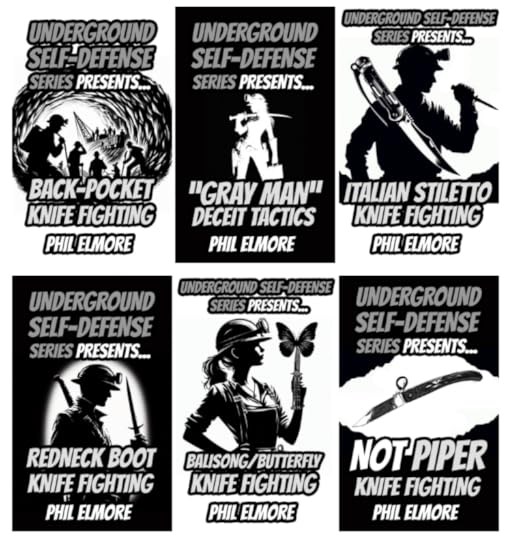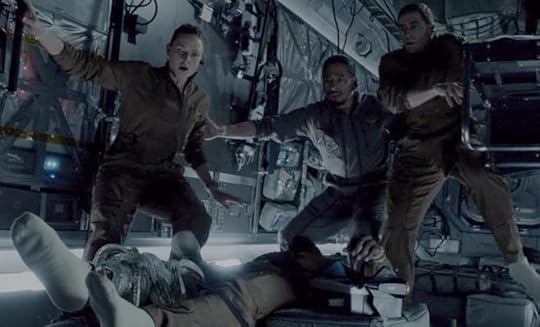Phil Elmore's Blog
August 6, 2025
Follow me on Substack
The Phil Elmore Substack is a virtual action library of columns and articles for today’s man and woman of action. Get the latest political commentary, opinion, and insight from me, bestselling author Phil Elmore. You’ll also receive self-defense tips, survival advice, and the occasional eBook. I am a digital content creator and one of the two constants of the Internet. Subscribe today for free and get columns every Friday, or pay for a subscription and get columns every single day. See you there!
The post Follow me on Substack appeared first on Phil Elmore Dot Com.
June 30, 2025
The Summer of Content is here!
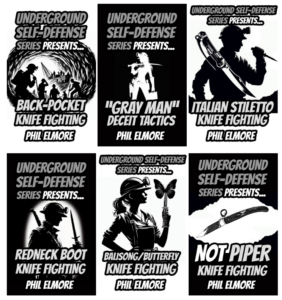 Check out my Summer of Content offer. This is the biggest book promotion I’ve ever done. I’m publishing 32 books before Fall!
Check out my Summer of Content offer. This is the biggest book promotion I’ve ever done. I’m publishing 32 books before Fall!
Buy before 15 July, 2025 and get free access to my seminar, Confessions of an Internet Marketer: How the Self-Defense Industry Manipulates You. The class will take place at the end of July.
The post The Summer of Content is here! appeared first on Phil Elmore Dot Com.
April 23, 2025
Summer 2025 is Here
The summer of 2025 stands to be a content-rich experience. I have multiple writing projects coming to fruition, both on Amazon and as part of the Underground Series. I look forward to sharing with you all this culmination of so many hours of work. Here’s to a great summer for all of us.
The post Summer 2025 is Here appeared first on Phil Elmore Dot Com.
January 3, 2023
ChatGPT and AI Writing is Stupid and You Shouldn’t Use It
As a writer who has worked for many years to become good at what I do, I have to admit to a visceral, knee-jerk response whenever anyone mentions AI writing. The proliferation of news articles and think pieces about ChatGPT, in particular, would have you believe that the robots have already taken over. Why, college professors are discovering to their horror that their students are using the AI to write college papers. The nation’s copywriters, we are told, will soon go the way of horse-and-buggy whip manufacturers. Why, it’s only a matter of time before AI is spewing out complete works of fiction, as even now it is being used to produce “art” (as long as you aren’t particular about the number of fingers your models have).
Except that this is all stupid and it’s not happening. At least not now.
The current generation of AI (at least what’s available to the public) is capable of doing a few things reasonably well. It can sound like it was written by a person instead of a random word generator… as long as that person has a brain injury or is just mildly stupid. It can be used to “respin” content to change the wording in a way that could allow you to use the same previously written blog post for more than one client, I suppose. The last time I tried software meant to do this, a number of years ago, it was absolutely wretched, so today’s AI certainly has set the bar higher.
For producing anything that actually sounds good, however, you still need a human being trained to write. Writing is something anyone can do as long you aren’t particular about the quality of the output. Even machines can spit out words in arrangements that conform to predefined rules of grammar and syntax. But there is no AI right now that can produce text you’ll want to read or that you’ll enjoy reading.
Non-fiction produced by AI is… mediocre. If you’re okay with your writing never surpassing a mild, “That was okay, I guess,” then certainly, you can use it. Just understand that nobody’s going to be impressed. If your writing application can be satisfied with a comfortable, often stilted mediocrity, I guess there’s no issue.
Fiction produced by AI, however, sounds like it was written by someone who was scribbling in a notebook while running up a “down” escalator. Here is a good example. I asked ChatGPT to write me a story about World War 1 trench warfare featuring a Private Jerry O’Connell. Here’s what it crapped out:
Private Jerry O’Connell was just a young man when he was drafted into the army to fight in World War 1. He had always dreamed of being a hero and defending his country, but he never expected the brutal realities of trench warfare.
Jerry was assigned to the front lines, where he spent day and night in a cramped, muddy trench with his fellow soldiers. The constant threat of enemy attacks and gunfire made it almost impossible to get any rest.
One particularly cold and rainy night, Jerry was on watch duty when he heard the sound of footsteps approaching the trench. He immediately sounded the alarm and grabbed his rifle, ready to defend his comrades.
As the enemy soldiers came into view, Jerry opened fire, taking out several of them before they could even get close. But there were too many of them, and soon Jerry was overwhelmed.
Just when all hope seemed lost, a group of reinforcements arrived to help drive the enemy back. Jerry and his fellow soldiers were able to hold the line, thanks in large part to Jerry’s bravery and quick thinking.
From that day on, Jerry was hailed as a hero among his comrades. Despite the horrors he had faced, he remained determined to keep fighting for his country until the war was won.
Now, here’s a passage written by an actual human being — me — about exactly the same topic.
O’Connell slumped into the mud, feeling it ooze down his back. His arms were numb. He no longer felt the hilt of the trench knife clenched in his hand; he no longer heard the rattling breaths of the German soldier dying in the muck at his feet. He was home again, in Alyssa’s arms, finally warm and full and safe. No one was trying to kill him. He had no blood on his hands.
“Private,” barked Sergeant Hauser above him. “Are you all well? Private!”
O’Connell looked up, barely recognizing the man. He could not seem to loosen his grip on the trench knife. The blade oozed crimson. In the mud and filth around him, the German’s blood mixed with the muck in the trench. O’Connell no longer cared.
“I… I’ m not injured, Sergeant,” he managed.
The Sergeant considered him, perhaps wondering if Private Jerry O’Connell had finally broken. With uncharacteristic compassion, he said, “Steady, lad. We’ve beaten the advance. They’ll hail you as a hero, O’Connell.”
O’Connell looked down at his hopelessly jammed rifle. He looked back to the Sergeant, but the man was already moving down the trench, checking on the dead, the dying, and those who remained.
A hero. Jerry O’Connell did not feel like a hero.
He only wanted to go home.
Now, I ask you: Which would you rather read? More importantly, which piece of work represents the level of quality you’d like to have associated with you or your business… and which sounds like something a not-too-bright tween would turn in for a sixth-grade reading assignment?
I realize just how appealing a shortcut AI must seem. Not everyone can write. Not everyone can create art. I know several artists who are appalled at the proliferation of AI picture generators. Honestly, if an AI can squat it out, what you’re holding isn’t “art” at all. But for someone without the talent to create art themselves, the allure of a machine that can do it for them is undeniable. Whether art or writing, whether non-fiction or fiction, AI represents a shortcut of which countless people are desperate to avail themselves. That’s understandable.
The problem, however, is that AI simply isn’t good enough not to sound (or look) stupid and awkward. Even when AI improves to the point that it is no longer stilted or obvious (and we’re rapidly approaching that point), it will never have the passion or the independent judgment of a human being who knows how to create. That’s going to be an insurmountable gap in any attempt to use AI to replace a human being. Simply put, you can’t and you won’t, no matter how good the computing power gets.
March 3, 2022
Available For Interviews
I’ve found myself doing a lot of press recently. Feel free to contact me for an interview.
NOTE: Appearances do not constitute an endorsement of the interviewer.
No Internet drama, please.
April 26, 2021
Self-Publishing Report – Ghost Writing Report Launches
I’m launching a new coaching business intended to help people (and companies) with their writing.
If you’ve always wanted to write a fiction or nonfiction book, but don’t know where to start… if you think you need a non-fiction book for your business, but you’re not a writer… if you’ve started your own book but aren’t sure how to finish it (or aren’t happy with it), and even if you’ve finished a book but don’t know where to take it now, the Self Publishing Report – Ghost Writing Report can help you take your book from idea to finished book to fully developed funnel for making money.
Coming up, we’re going to be offering a Writer’s 4-Week Fast Class that teaches you 4 critical components of writing any book. More details will be available in coming days. You can stay up-to-date on what we’re doing in our Facebook Group, linked here. I’d be honored if you joined!
January 27, 2020
I’m Looking For Work
I’m looking for remote work as a technical writer / content creator. Please don’t hesitate to contact me at US +1.315.391.1626 or phil [at] philelmore.com . Thanks!
December 5, 2017
Jerry and Sharon Ahern’s “America Undead” (by Phil Elmore)
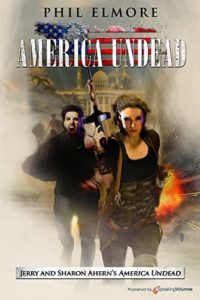 As a teenager I was a huge fan of Jerry Ahern, whose series The Survivalist was not just entertaining, but also educational. Jerry knew his way around firearms and never failed to fill his books with knowledge. He was also something of a frustrated science fiction author, as most of his books eventually veered into science fiction territory as they progressed. I collected most, if not all, of Jerry’s work, in the process discovering that he co-wrote with his wife, Sharon.
As a teenager I was a huge fan of Jerry Ahern, whose series The Survivalist was not just entertaining, but also educational. Jerry knew his way around firearms and never failed to fill his books with knowledge. He was also something of a frustrated science fiction author, as most of his books eventually veered into science fiction territory as they progressed. I collected most, if not all, of Jerry’s work, in the process discovering that he co-wrote with his wife, Sharon.
Before Jerry’s death, he and Sharon conceived a new story idea — one involving vampires. Jerry took me up on an old author I made, as a fan of his, to co-write something with him. “America Undead” was born. I can’t tell you how it makes me feel to know that something I wrote — the first chapter of “America Undead” was among the last things he ever read. I am saddened he cannot be here to see the finished product, but honored to be able to contribute to the Aherns’ writing legacy in this small way. Get your copy of Volume One of the “America Undead” series here.
Survive: Live Well and Live Wisely
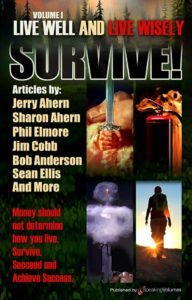 To be billed next to Jerry and Sharon Ahern, not to mention Bob Anderson, is a pretty big box checked on my list of life achievements. As a teenager I loved Jerry Ahern’s Survivalist series. I would later go on to write a new property for Sharon Ahern and the Ahern estate — an idea created by Jerry and Sharon before Jerry’s death. In the non-fiction realm, however, I was also honored to contribute to Survive: Live Well and Wisely. Get your copy here.
To be billed next to Jerry and Sharon Ahern, not to mention Bob Anderson, is a pretty big box checked on my list of life achievements. As a teenager I loved Jerry Ahern’s Survivalist series. I would later go on to write a new property for Sharon Ahern and the Ahern estate — an idea created by Jerry and Sharon before Jerry’s death. In the non-fiction realm, however, I was also honored to contribute to Survive: Live Well and Wisely. Get your copy here.
June 4, 2017
Ode to the Cast-Elimination Film
One of the most enjoyable and interesting things about writing is finding the common themes, methods, and mechanisms employed by writers across a culture or category. In screenwriting, for example, there are only so many tropes that can be employed, only so many plot devices that can be invoked. Emphasizing the finite nature of this pool of ideas is the fact that human beings prefer to watch the same thing over and over. The Save the Cat formula perfectly illustrates this: The Force Awakens is the same screenplay as A New Hope. Yojimbo is The Warrior and the Sorceress is Fistful of Dollars is Bruce Willis’ Last Man Standing.
I was hooked on this concept the moment my father announced, during a cable showing of Sean Connery’s Outland (a movie that is itself High Noon in space), “Watch, that guy will be dead already.” Sure enough, when Connery enters the holding cell area, the suspect he wants to interrogate has been murdered. I thought my father had seen the movie before, but he hadn’t. I wondered if he might be some kind of wizard. The truth was simply that he had seen movies before. I have been fascinated by the commonality of writing design since that moment.
Recently I watched the film Life, a very typical entry in the survival-horror and science fiction categories. The movie perfectly exemplifies everything that happens in a movie about dying in space, a movie about humans pitted against a Big Bad (be it a monster, a murderer, or a force of nature) and — most importantly — a movie about characters being eliminated one by one. It is therefore what I have for years referred to as a cast-elimination movie.
You’ve seen countless cast-elimination films. Some of the classics of the genre are Alien (or Aliens), The Thing, and every zombie movie. But don’t think that a cast-elimination film is always about monsters, or that the genre is limited to science fiction and horror. Clue is a cast-elimination murder mystery in which victims are wiped out one by one. Thirteen Ghosts and House on Haunted Hill (original and remake alike) are supernatural or pseudo-supernatural versions of the idea. The Magnificent Seven is a cast-elimination Western. Even Star Wars: Rogue One is a cast-elimination film, as are many other war movies. (You could argue that Rogue One and Magnificent Seven are almost the same movie. We could call the sub-genre a Rally Team Cast-Elimination film, in which a group of assembled heroes loses most of their number while fighting for some cause.)
The framework of a cast-elimination movie can be placed over many types of screenwriting. The Hateful Eight is, to some extent, a cast-elimination film, and also a “bubble” screenplay in which all the action takes place in one location. (I like bubble scripts because they put the action on the writing, not on set pieces or action sequences.) The science fiction film Cube (we’ll ignore its increasingly bad sequels) was both a bubble script (because the set was self-contained, standing in for multiple different chambers) and a cast-elimination movie. The point of the film was seeing which characters died — and when.
What is eliminating the cast is not important except insofar as plot mechanics go. The Big Bad is a plot driver and need not even be personified. In The Grey, wolves are the Big Bad. In Deep Blue Sea, it’s sharks. In movies like Pitch Black, Life, Alien, and The Thing, alien monsters are the Big Bad. But in The Poseidon Adventure and its remake — all disaster films are essentially cast-elimination films, although some put more emphasis on taking out characters than others — the Big Bad is an external force that puts the characters in peril. Whether your cruise ship is sinking, your San Andreas fault just faulted, or your towering tower is inferno-ing, some mortal peril is driving the plot to get characters from where they start to some goal or goals. The Big Bad exists to eliminate the characters one by one during the trek.
Cast elimination movies aren’t always serious. Cabin in the Woods sends up the genre and is both a parody of it and an entry in it. We’ve mentioned Clue, which is a comedy. There is no one tone, no one approach, that defines cast-elimination films. What they all have in common is that they ask the audience to wonder — to hope, even — who will survive the movie.
Some cast-elimination films have what I call the “F–k you, movie!” ending, in which everyone dies and you’re left wondering why you bothered. They quite literally make you want to swear at the movie for wasting your time. In some cases, a movie franchise waits until a sequel to shout “F–k you!” at the viewer, such as in Alien 3 (where the little girl saved by Ripley in Aliens has been killed off screen). Most of the time, though, it hits you right at the conclusion of the movie, sometimes as a deliberate plot twist, and other times because the writers simply didn’t know what to do. One of the worst examples of a “F–k you, movie!” ending is probably found in Thomas Jane’s The Mist, an ending altered from Stephen King’s novella (and which King stupidly praised, saying he wished he’d thought of it first).
For our purposes, then, we define any cast-elimination film as one in which the point of the movie is to see who will survive (and how they will do so). The subset of cast-elimination movies, called “F–k you, movie!” movies, are those in which nobody survives, or in which survival becomes a Pyrrhic victory.
Cast-elimination movies play on our desire, our basic instinct, to survive. We cannot help but project ourselves into the scenario and ask ourselves what we would do — how we would perform. Zombie movies especially invite the viewer to picture how he or she would fight back and go on to live. The Saw films ask this question in a more gory, even philosophical way. It’s easy for a cast-elimination movie to devolve into torture-porn or virtual snuff-film territory if the writing is crudely executed — something with which so many cast-elimination sequels flirt.
So, how do we judge a cast-elimination film? There’s no universal standard. My basic formula is that most of these movies boil down to the Alpha Male and the Alpha Female. There’s a preference for women to survive over men, so if only one may live, it will typically be the Alpha Female. Characters with tear-jerking backstories, like devoted parents fighting to get back to kids or hard-worn veterans close to retirement, almost always die. Children and cute animals almost always survive such a movie, so if you find yourself in one, stay close to the kids or their adorable pet dog. Comic relief characters have about a fifty-fifty shot. Some survive, while others die. (If that character is LL Cool J, his chances drop to about one third.) Characters guilty of moral offenses, or who admit to having done things that are morally wrong, typically die as a way of making penance for their sins. (This is Movie Law.)
To me, the best cast-elimination films are those that disrupt this formula and become totally unpredictable. They’re rare, but they happen. Deep Blue Sea is probably one of the best examples of this, but there are others. If you can find films like this, you’ll be adding true gems to your catalog of seen movies… and that’s what makes cast-elimination films so much fun. Many are predictable, but even lots of those are fun to watch.
It’s always about being able to predict who’s going to die and who’s going to live. As Joe Bob Briggs said, a horror movie is one in which “anyone can die at any time.” The best cast-elimination movies take this dictum to heart.

